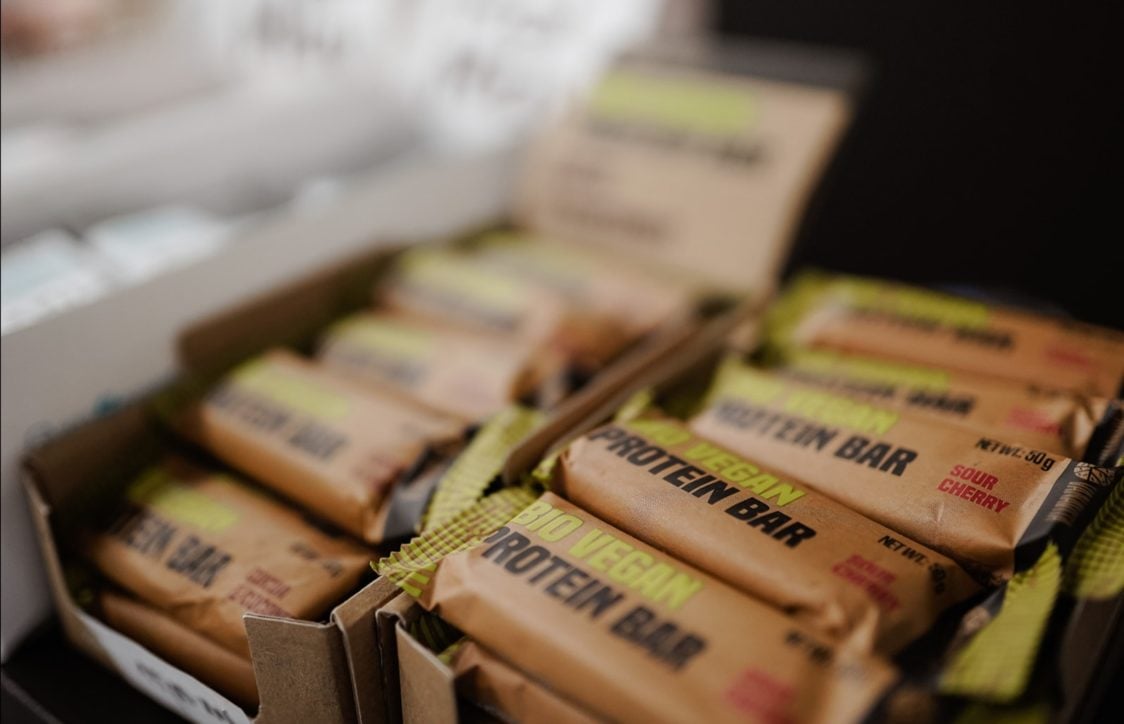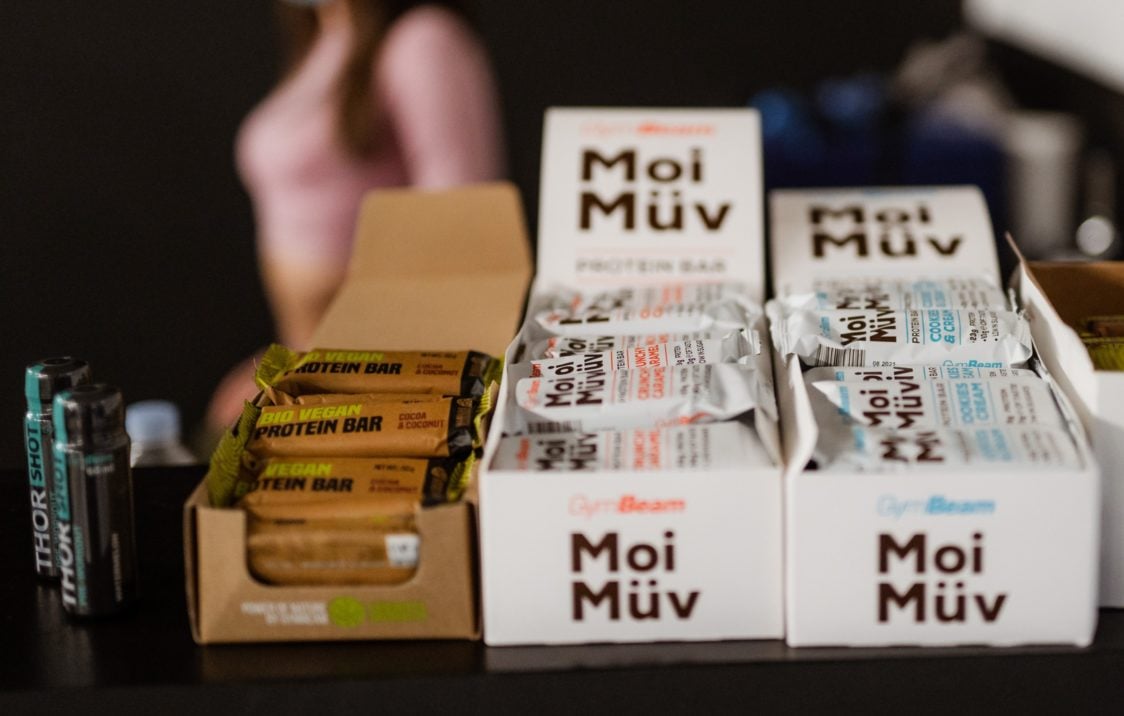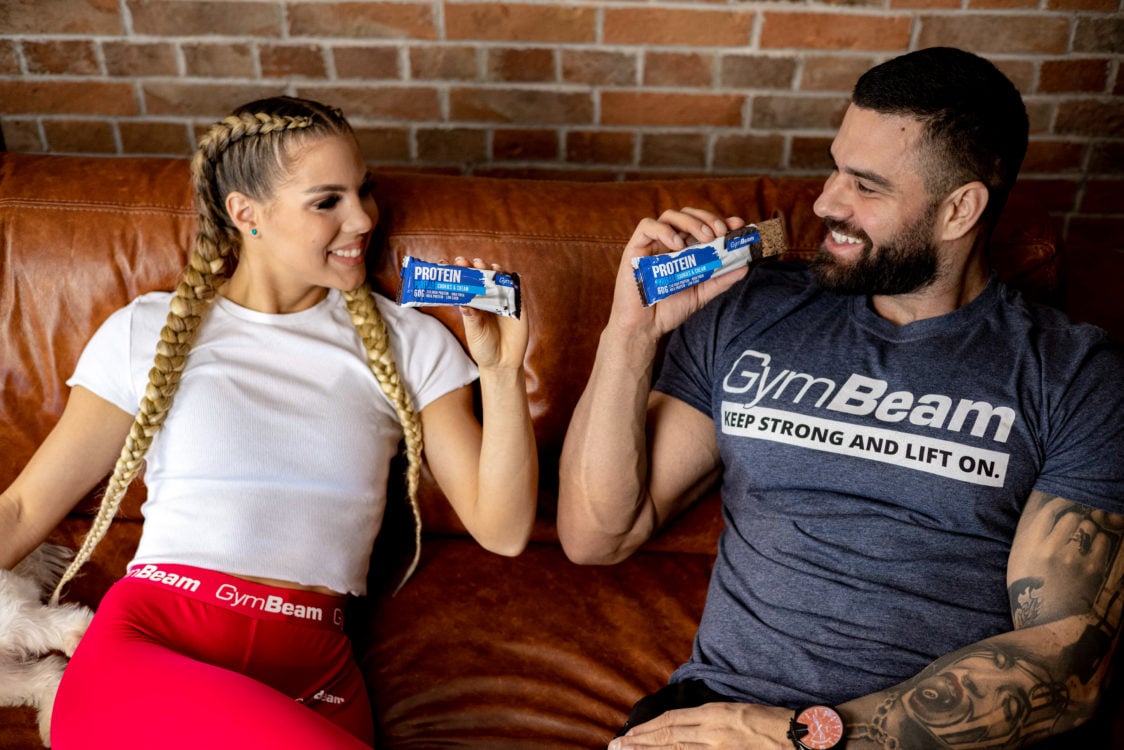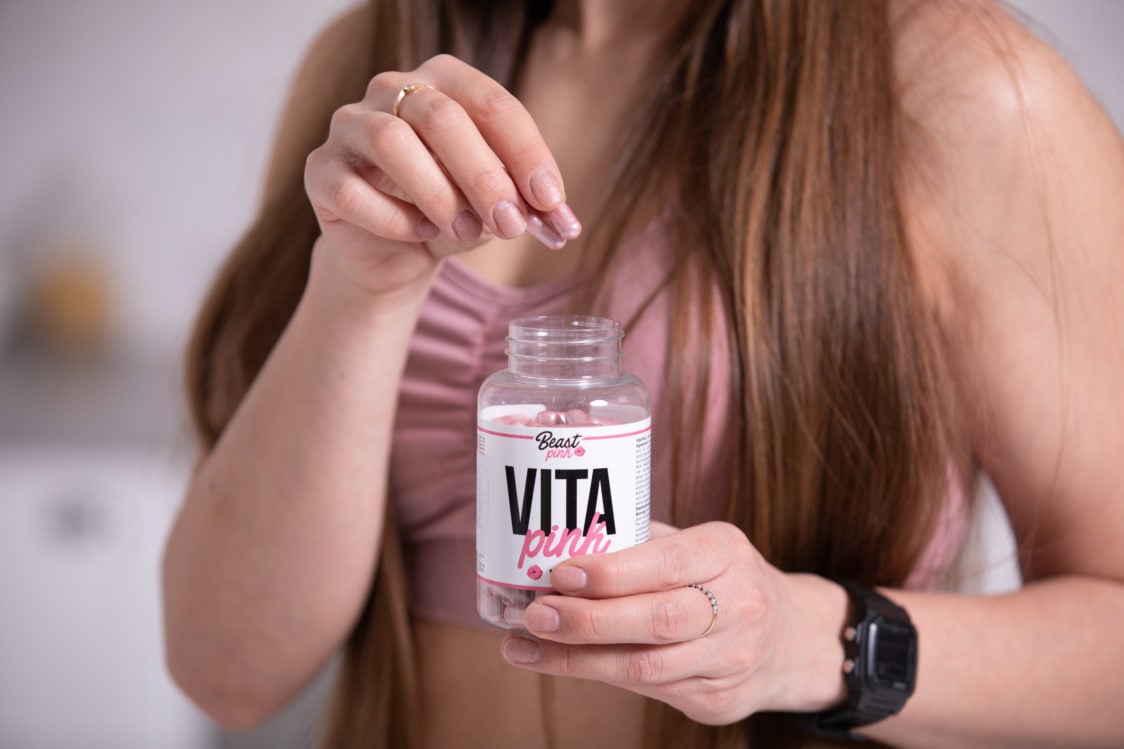Table of Contents
Protein bars have rightly become a common part of our diet. And no wonder. They’re a great snack when you’re in a hurry and need to quickly satisfy your hunger and your taste buds. You can literally use them as a hunger first aid at work, studies, hiking or on the ski slope.
However, there are significant differences in the ingredients profile of different protein bars. You can easily discover which protein bar is a good one and which one should be left on the shelf. Let’s take a closer look at what a protein bar actually is, what it consists of, when it is appropriate to eat it and how to choose the best quality one.
What is a protein bar?
A protein bar is usually a bar that is high in protein at the expense of carbohydrates and fat. This is mainly why it is popular with people who watch their intake of this macronutrient and are not indifferent to what they eat. A higher protein content is usually achieved by adding various animal or vegetable protein sources. This is partly how you can tell how good the bar is and whether your body is really getting the nutrients it needs from it.
When to eat protein bars?
Protein bars – You can eat a protein bar almost anytime, it just depends on your cravings, hunger and energy demands.
In general, however, they are most often used as:
- part of breakfast when you are running late
- a quick snack at work or university
- snacks for hiking, skiing, cross-country skiing, cycling and other activities
- a snack before or after a workout
- a dessert with coffee that also fills you up
- a diet snack, weight maintenance and weight gain
Wondering what the ideal snack should look like? Find all the information you need in our article What Should a Balanced Snack Include and How to Healthily Replace Calorie Dense Snacks?
Are protein bars suitable for children?
In general, you don’t have to worry about protein bars containing ingredients that are unsafe for children. So why can’t you find protein bars in the shops that are aimed directly at little ones? The answer is simple, a child’s body doesn’t need as much protein as an adult’s due to their size. Therefore, there is no need for younger children to supplement protein with any special foods. A healthy, varied and balanced diet will do just fine. On the contrary, excessive protein intake could put unnecessary strain on their bodies and cause digestive problems such as bloating. [1]
However, the situation is different for adolescent children over fifteen years of age who are in the process of development and also play sports. Their weight then increases, and at the same time their need for protein increases. In this case, the inclusion of protein bars in their diet may make sense.

What to look for when choosing a protein bar?
As is usually the case with consumer goods, we can usually choose between different quality products. And it is no different with protein bars. However, price and shiny colourful packaging with a striking design is not the main criterion for evaluating a quality protein bar. You should be interested primarily in the ingredients used, their ratios and the resulting macronutrient values of the bar itself. These three main criteria will help you find the best quality protein bar specifically for you.
1. Protein
Protein is the key macronutrient in protein bars. Compared to regular bars or various sweets, their proportion is usually higher. However, the protein source used is just as important. Let’s take a closer look.
How much protein should a protein bar have?
To qualify as a protein bar, it must be naturally higher in protein at the expense of carbohydrates and fat. So how much protein is that?
- According to EU guidelines, a bar must have at least 12% protein of its total energy value to be called a protein source and to carry the label protein or protein bar. For example, the packaging often also states that it contains protein. To give you an idea – if a protein bar contained 400 kcal per 100g, it would have to have at least 12g of protein in the same amount. For a 50g bar, that would be only 6g of protein. [2]
- In order for a bar to be said that it is high in protein, the energy value of this macronutrient must make up at least 20% of the bar. On its packaging, for example, you can also find information that it is high in protein. To give you an idea – if a protein bar contained 400 kcal per 100g, it would have to have at least 20g of protein in the same amount. For a 50g bar, that would be 10g of protein. [2]
As you can see, a protein bar may not contain as much protein as you would expect, even though it is labelled as high in protein. Fortunately, however, there are options available in which protein makes up 30-40% of the energy value of the bar. So you can easily reach the magic 20g of protein per serving with a 60 g bar.
What source should the protein in a bar come from?
The amount of protein is one thing. However, the source of the protein and the associated amino acid profile are equally important. This has an impact on how our body will use them, for example, whether the contained amino acids will go primarily to connective tissues or will be used for muscle growth. Similarly, the origin of the protein also influences its absorption and availability to the body.
The best sources of protein in everyday protein bars
If you are not a vegan and do not avoid any sources of protein, the best choice for you will be a bar consisting mainly of protein from milk, which has a great amino acid spectrum. In fact, it contains all the essential amino acids in an almost optimal ratio. Specifically, this can be:
- Milk protein – this is known to contain approximately 20% whey protein and 80% casein protein [3-4]
- Whey Protein Concentrate (WPC) – a high quality protein that has excellent absorption and affordability [5]
- Whey Protein Isolate (WPI) – obtained by filtration from whey concentrate, which makes it “cleaner” (contains less fat and carbohydrates compared to WPC), is quickly absorbed and suitable for lactose intolerance [6–7]
- Whey Hydrolysate (WPH) – produced from whey concentrate or isolate by the process of hydrolysis, thanks to which it is perfectly digestible for the body and the most readily available [8]
- Micellar Casein – is known for its gradual absorption, which is why it earned the nickname “night protein”, its admixture is ideal if you want to be fuller for longer
However, you won’t go wrong with egg albumin from animal sources either. This is a protein powder that is created by drying the pasteurised egg white from hen’s eggs. However, it also has the advantage of a favourable amino acid spectrum.

Which protein sources to avoid?
If you’re looking to grow muscle, beef collagen is probably not the optimal source for you. This is a protein found mainly in connective tissues. Therefore, it is optimal especially for people who want, for example, to take care of their joints, improve the quality of their hair or nails, or increase the elasticity of their skin and reduce wrinkles.
If this is your goal, then you don’t have to avoid beef collagen. However, if you want to support muscle development and recovery after training, then milk protein or egg albumin is a better choice. [9]
The best sources of protein in vegan protein bars
Nowadays, even vegans can choose a quality protein bar. There is a plethora of bars on the market that are made up of only plant-based ingredients, including protein. However, with these, you need to focus even more on the protein sources and their proportion so that you really get the most out of the bar. Let’s take a closer look at them:
- Soy protein – thanks to its relatively favourable amino acid spectrum, it is most similar to high-quality whey protein and is one of the most popular protein sources among vegans. [10–11]
- Rice protein – is another vegan source of protein that is also popular among people with lactose intolerance. However, it does not have the most suitable amount of the essential amino acid lysine, so it is beneficial to combine it with with pea protein. [12–13]
- Hemp protein – is produced by pressing and grinding hemp seeds. Its amino acid spectrum perfectly complements, for example, pea protein. [14]
- Pea protein – legumes are great alternatives to animal proteins. They have quite high amounts of essential amino acids that are often missing in plant sources. Their shortcoming is, for example, their low methionine content, so combining them with rice protein or another cereal protein is ideal.
As you can see, some plant proteins have certain deficiencies, for example in the form of a less favourable representation of some essential amino acid (limiting amino acid). However, you can easily eliminate these with a suitable combination. When selecting a vegan protein bar, always choose one that ideally has multiple protein sources in its ingredients list, or for example a soy or other legume protein.
Key recommendations on protein in protein bars
- If you’re looking for a bar with a higher protein content, reach for one that has at least 20g of protein per serving.
- If you’re not vegan, a bar containing milk protein might be the best choice for you. This could be whey protein or micellar casein, for example. However, you won’t go wrong if the bar contains egg albumin either.
- Vegans do better if they choose a bar that combines multiple protein sources (e.g. rice protein with pea protein). This gets rid of the deficiency in the form of a specific limiting amino acid and provides a snack with a more favourable amino acid spectrum. A good combination may be, for example, a combination of soy and legume protein.
Want to learn more about the quality of protein in protein bars? Then you should not miss our article How to Choose the Right Protein for Weight Loss or Muscle Growth?

You might be interested in these products:
2. Carbohydrates
In addition to protein, you should also give attention to the proportion of carbohydrates and their sources. The right choice can ensure, for example, that the bar is lower in calories, satiates for a longer period of time and progressively provides energy. So let’s take a closer look at carbohydrates as well.
How many carbohydrates should a protein bar have?
For carbohydrates, one cannot clearly state exactly how many grams a bar should contain. Depending on the weight of the bar, one may see different values. Similarly, in terms of carbohydrate content, you need to take into account who the bar is intended for. For example, if you’re on a low-carb or a keto diet, you’ll probably want to keep the carb content as low as possible. Let’s image you want to have some protein bar as a snack after a workout, for example, and you don’t have any specific dietary restrictions. You’ll want to find a protein bar that would provide your body with a certain amount of carbohydrates needed to regenerate your body’s energy stores.
However, if we were to provide a general universal recommendation that should be suitable for most people, the amount of carbohydrates would be between 10-25 g per 60g. For a bar that has 400 kcal in 100g, this would mean that carbohydrates make up about 17 – 42%. However, the range of carbohydrate content in the bars that are available on the market is much wider, so you are sure to find one that suits your intake best.
And what about sugar in protein bars?
As well as the total carbohydrate content, you should also be interested in sugar proportion. Again, we can’t specify something like good and bad amounts. The ideal proportion of sugar will depend on your goal. For example, if you’re trying to bulk up and have a protein bar as a quick snack before a workout, you may not be significantly bothered by higher amounts of sugar. If you’re eating a bar at work during the day, for example, and want it to give you gradual energy and keep you full for longer, it’s a good idea to choose a lower sugar content. This is also in line with the WHO (World Health Organisation), which recommends tightening the overall limit for eating added sugars from 10 to 5% of total daily energy intake. For a person with an intake of 2500 kcal, this would mean a reduction from about 62g to 31g. [23]
Let’s try to make it a little simpler. We believe that the average 60g bar should generally contain about 5g of sugar. You definitely can’t go wrong with that amount, and you can expect the bar to gradually give you energy and you won’t be hungry right away.
With organic (BIO) products, the situation is a bit more complicated, so the amount may be slightly higher. This is mainly due to the use of purely natural ingredients that naturally contain sugar. But you don’t have to worry about this either, it’s okay.
The best sources of carbohydrates in protein bars
In addition to the amount of carbohydrates, you should also be aware of their source. You don’t want a protein bar loaded with sugar without any complex carbohydrates to fill you up, do you?
The following types of carbohydrates are most commonly found in protein bars:
- Simple sugars – they deliver a sweet taste, but they should not make up the majority of the carbohydrates in the bar. These include glucose, fructose or glucose-fructose syrup.
- Complex carbohydrates – they are released gradually and fill you up for a longer period of time. These are for example, various oats, flour or starch.
- Polyols or polyalcohol’s – are similar in structure to carbohydrates, but have a lower energy value. The great advantage is that they do not contribute to tooth decay. They include maltitol or erythritol, which are also naturally occurring in fruit and contain no calories. However, for some, excessive amounts of maltitol, which are difficult to take in through the normal diet, could cause digestive problems. But if you have only one bar a day, you don’t need to worry about it. [15–16]
Key recommendations on carbohydrates in protein bars
- The ideal bar, which is filling and gradually provides energy, should contain approximately 10-25g of carbohydrates in 60g. Translated, this means that carbohydrates should make up approximately 17-42% of the energy value of the bar. However, if you’re following a low-carb or keto diet, for example, look for bars that contain as few carbs as possible.
- In general, we would recommend choosing bars that have around 5g of sugar, with the exception of organic (BIO) bars that contain purely natural ingredients.
- As far as carbohydrate sources are concerned, complex carbohydrates such as a variety of oats and starches should predominate in the bar. The sweet taste is then taken care of by polyols, which can replace sugar in a healthy way and reduce the total amount of calories in the bar.

3. Fats
Fat is the macronutrient that has the highest energy value, specifically approximately 9 kcal per 1g. Its content thus has a relatively significant impact on the final calorific value of the protein bar. And, as with other macronutrients, we distinguish between more and less preferable sources of fat. Let’s take a closer look at them.
How much fat should a protein bar have?
One smaller 60g protein bar contains approximately 5-10g of fat, which is perfectly fine. However, if you’re buying a bar designed for a specific eating plan, such as a low-carb or keto diet, the fat content will be higher at the expense of carbohydrates, which quite common. Again, however, each individual needs to assess the purpose of the protein bar, what they expect from it, and then choose a specific amount of fat based on that.
- If you are planning to have a protein bar after a workout and are striving for the fastest absorption of protein, a lower fat bar may be more suitable for you.
- In case you are trying to lose weight and the caloric value of the bar is a priority, it is better to go for a lower fat one.
- If you want a bar that’s as filling as possible, you don’t have to worry about a slightly higher fat content.
- And for those who follow a low-carb diet or keto diet, it’s probably not surprising that we recommend reaching for bars that have a higher fat content at the expense of carbohydrates.
The best sources of fat in protein bars
Even with fat, you probably won’t be blown away by the fact that there are different quality sources in the bars. Among the ones that are beneficial to health, we primarily consider unsaturated fats. These generally come from vegetable sources. These include, for example:
- cocoa beans
- nuts (except coconut)
- seeds
- canola oil
- olive oil
- flaxseed oil
However, not every fat is ideal for a protein bar. For example, the oils listed are among the healthy fats, and they also have a beneficial fatty acid content. Unfortunately, however, they are more easily subject to oxidation, which produces undesirable aldehydes and ketones. This is also one of the reasons why they are used less frequently in bars. The other reason is their specific taste, which may not be to everyone’s liking in a bar. [17]
In order to achieve the optimum taste, consistency, ideal balance of price and function, and to create a bar that does not oxidise easily, manufacturers often resort to using less popular fats. These are also known for their higher proportion of saturated fatty acids. These include:
- palm oil or fat
- palm kernel oil or fat
- coconut oil or fat
Therefore, if you see these fats listed in the ingredients, it does not necessarily mean that the bar is of poor quality and unsuitable. Due to their properties, they can play an important role to some extent. Since the fat content of regular protein bars is not very high, you don’t have to worry about the less popular fats having a negative effect on your health. [18]
Key recommendations on fats in protein bars
- An ideal protein bar that is not designed for a specific dietary type should have approximately 5-10g of fat.
- Protein bars designed for a low-carb diet or keto diet will have a higher fat content and that’s okay. With these, we should place greater emphasis on the quality of the fats used.
- Generally, fats such as those from cocoa beans, seeds, most nuts (except coconut) and various oils are considered healthier.
- In order to achieve the ideal consistency and to avoid oxidation of the bar, manufacturers also use a certain amount of less popular saturated fats such as palm, palm kernel and coconut fat. In the amounts that are in a protein bar, we don’t have to worry about their possible negative impact on health.
If you want to learn more about fats, you shouldn’t miss our article Fats, Which Are Bad and Which Are Good?

4. Fibre
Although fibre by its very nature falls under the category of carbohydrates, we decided to focus on it separately. Its content can play a key role in the absorption rate of the individual components of a protein bar. Fibre has only 2 kcal per 1g, but the utilisation of this energy also depends on our gut bacteria extracting this energy. It is generally beneficial for our health, and even has an effect on satiety. [19]
- If you want a bar to keep you full for longer, you should choose one that is high in fibre. For an average 60g bar, this means that it should contain at least 3.6g, according to EU guidelines. However, you can often find bars that have as much as 10g of fibre, which can help you meet your recommended daily intake even better. In addition to increased satiety, fibre is also important for healthy digestion. [20]
- However, if you are eating a protein bar as a post-workout snack, where you are trying to get the contained protein to the muscle fibres damaged by training as quickly as possible, a high fibre content is not desirable. It would unnecessarily slow down nutrient absorption, and hungry muscles would wait a long time for their energy. So after a workout, it is ideal to reach for protein bars with a lower fibre content. An even better choice, however, is to drink protein in the form of high – quality protein.
Fibre can come in many forms in protein bars and is often hidden under names that do not make it obvious at first glance that it is fibre.
So for example, look for the following sources on the packaging:
- inulin, i.e. from the chicory root
- corn fibre
- oat fibre
- isomalt-oligosaccharides
- fructooligosaccharides
Key recommendations on fibre in protein bars
- If you want a protein bar to fill you up, it is ideal that it has a high fibre content (i.e. at least 3.6g per average 60g bar), but ideally more. When we eat a bar after a workout and want to refuel your muscles as quickly as possible, it is optimal to choose a lower fibre content.

5. Sweeteners
We have already lightly touched upon the topic of sweetener content in protein bars in the chapter dedicated to carbohydrates. Since a protein bar should generally not contain more than 5g of sugar, the sweet taste needs to be achieved in a different way. And sweeteners are the ideal solution in this case. Their great advantage is usually their lower caloric value compared to sugar. As a result, the whole bar can also have a lower energy value.
Depending on their origin, sweeteners can be categorized into:
- sweeteners of natural origin – this includes, for example, stevia and thaumatin
- polyalcohol’s – synthetic sweeteners whose structure is identical to natural ones, such as erythritol, xylitol and maltitol [21]
- synthetic sweeteners – they are made by chemical processes, they include for example sucralose, aspartame, acesulfame K
However, we do not need to worry about any of these sweeteners. Both the European and the US Food and Drug Administration have confirmed that they are safe within daily limits. However, these values are quite high, so you shouldn’t worry even if you have a few protein bars and wash them down with sweetened lemonade. [22]
Key recommendations for sweeteners in protein bars
- Sweeteners are not dangerous and you don’t have to worry about their content in protein bars. If you’re looking for the lowest possible calorie content, you might like bars sweetened with stevia or erythritol, which are calorie-free.
6. What else can we find in protein bars?
In addition to the above ingredients, some bars contain flavourings, fillers, stabilisers and other substances in the bars that help to complete their consistency, taste or aroma. Moreover, they are often enriched with various vitamins, minerals and caffeine. Their share in the composition can be a nice benefit, but you should definitely not rely on the fact that the protein bar will provide you with all the micronutrients the body needs. It simply doesn’t work that way. Still, the foundation of any diet is a varied and balanced diet with plenty of colourful fruits, vegetables and other whole foods.
And if you still feel that you would like to supplement vitamins, minerals and other beneficial ingredients in other ways, it is better to reach for concentrated supplements that will help you more effectively.

7. Caloric value
The resulting caloric value of the bar is to some extent a reflection of its ingredients. Again, we cannot say one number that represents its ideal energy value. However, we can use the example of the MoiMüv protein bar to show how the ingredients affect calorific value and how many kcal an average protein bar might contain.
Approximate values of protein bar MoiMuv (cookies & cream flavour):
- 23g protein (92 kcal)
- 14g carbohydrates (56 kcal), of which 1.9g is sugar
- 6g fat (54 kcal)
- 7g of fibre (14 kcal)
The ideal snack is a protein bar, which has approximately 200-250 kcal per 60g. Since it does not add a large amount of energy to your daily intake, it is also great for weight loss. Likewise, it can be one of the snacks for people who are trying to gain weight. In this case, however, it is advisable to supplement the bar with another meal.
The aforementioned MoiMüv protein bar has 60g. However, there are also protein bars that are 90g or more. Similarly, different types may have a noticeably higher proportion of fat. In this case, one bar can have as much as 400 kcal.
To give you an idea, the same amount of calories is also approximately:
- 650g apples
- 75g milk chocolate
- 400g chicken ham
When you’re bulking up, a protein bar with a higher fat content can be a good way to get calories in easily. But when you’re dieting, you’ll need to think harder about whether 650g of apples or one bar will satisfy you better. So remember to read the ingredients and don’t be tempted by the fancy packaging that says protein.
Want to learn more about how to calculate your recommended calorie intake? Then you shouldn’t miss our energy intake and macronutrient calculator.

What the ideal protein bar should look like?
And finally, we are slowly getting to the most important thing. So how should the ideal protein bar be formulated to serve as a great snack during the day, fill you up, replenish important macronutrients and give your body consistent energy?
- Weight: The ideal weight of the bar should be approximately 60g as this will ensure that it drives away minor hunger pangs, satisfies cravings and doesn’t burden our digestion too much.
- Protein: a bar should preferably have at least 20g of protein. Generally, milk protein or egg albumin is the best choice. Vegans should ideally reach for a bar containing a combination of several plant sources, such as rice and pea protein. Soy with a legume protein source is also a good choice. This gets rid of the deficiency in the form of a limiting amino acid.
- Carbohydrates: The bar should have approximately 10–25 g of carbohydrates, of which about 5g of should be sugar.
- Fat: Smaller protein bars of about 60g usually have 5-10g of fat, this seems to be optimal. Ideally these should be unsaturated fat sources, which include for example, cocoa beans, seeds and most nuts. However, you don’t have to worry about the less popular fats either.
- Fibre: Try to look for a bar that has at least 6g of fibre per 100g. Ideally try to find a bar with a higher fibre value.
- Sweeteners and other ingredients: you don’t have to worry about sweeteners and substances that are used to create the final taste, aroma and consistency. The amount of sweeteners contained in the bars is in no way harmful to health. However, if you avoid artificial sweeteners, bars that use polyols to provide the sweet taste can be a great alternative.
- Caloric value: in the case of a 60g bar, the ideal energy value should be around 200 kcal. This will ensure that the bar makes an ideal snack even when losing weight.
What should you remember?
As you can see, a protein bar is the perfect snack that you’ll love for a variety of occasions. It can fight off sudden hunger at work, studies, on a hike, a bike ride, the ski slopes, but it can also satisfy your taste buds when you’re hungry, for example, when you’re losing weight. But before you buy a protein bar, always read the ingredients and take a closer look at the nutritional table. After reading this article, you should be able to separate the wheat from the chaff and put only selected quality products in your shopping basket. That way you will do best for yourself.
Do you have someone among your friends who haven’t tried a protein bar yet? Share our article with them so they don’t voluntarily deprive themselves of this delicious treat.
[1] EFSA – Dietary Reference Values for the EU – https://multimedia.efsa.europa.eu/drvs/index.htm
[2] Nutrition claims – https://ec.europa.eu/food/safety/labelling-and-nutrition/nutrition-and-health-claims/nutrition-claims_en
[3] Hanne B Jensen et al. – Comparative proteomic analysis of casein and whey as prepared by chymosin-induced separation, isoelectric precipitation or ultracentrifugation – https://pubmed.ncbi.nlm.nih.gov/22998726/
[4] Phil Kelly Manufacture of Whey Protein Products – https://www.researchgate.net/publication/330046067_Manufacture_of_Whey_Protein_Products
[5] WHEY PROCESSING – https://dairyprocessinghandbook.tetrapak.com/chapter/whey-processing
[6] C. V. Morr et al. – Whey protein concentrates and isolates: Processing and functional properties – https://www.tandfonline.com/doi/abs/10.1080/10408399309527643
[7] Nissim Silanikove et al. – The Interrelationships between Lactose Intolerance and the Modern Dairy Industry: Global Perspectives in Evolutional and Historical Backgrounds – https://www.mdpi.com/2072-6643/7/9/5340/htm
[8] RhichaSinha – Whey protein hydrolysate: Functional properties, nutritional quality and utilization in beverage formulation – https://www.sciencedirect.com/science/article/abs/pii/S0308814606003050?casa_token=iURxfPjthXcAAAAA:T5aVEauJtBK9N2Y93tSmzaNpnvjHk6xnDUigTDQevx52QKAa55v_DV1AerwlNjQq_xcVzyk0iQ
[9] Beef protein: anabolic underdog? – – https://examine.com/members/deep-dives/article/beef-protein-anabolic-underdog/
[10] Jason E Tang et al. – Ingestion of whey hydrolysate, casein, or soy protein isolate: effects on mixed muscle protein synthesis at rest and following resistance exercise in young men – https://pubmed.ncbi.nlm.nih.gov/19589961/
[11] E W Lusas et al. – Soy protein products: processing and use – https://pubmed.ncbi.nlm.nih.gov/7884536/
[12] Martin Purpura et al. – Ingestion of Rice and Whey Protein Isolate: A Double-Blind Crossover Study – https://www.researchgate.net/publication/266560111_A_Comparison_of_Blood_Amino_Acid_Concentrations_Following_Ingestion_of_Rice_and_Whey_Protein_Isolate_A_Double-Blind_Crossover_Study
[13] Limiting amino acids – https://www.asi.k-state.edu/research-and-extension/swine/swinenutritionguide/limitingaminoacids.html
[14] Hemp Protein – https://examine.com/supplements/hemp-protein/
[15] Geoffrey Livesey – Health potential of polyols as sugar replacers, with emphasis on low glycaemic properties – https://pubmed.ncbi.nlm.nih.gov/19087388/
[16] Ariana Saraiva et al. – Maltitol: Analytical Determination Methods, Applications in the Food Industry, Metabolism and Health Impacts – https://www.mdpi.com/1660-4601/17/14/5227
[17] E. R. Sherwin – Oxidation and antioxidants in fat and oil processing – https://aocs.onlinelibrary.wiley.com/doi/abs/10.1007/BF02682653
[18] Is saturated fat bad for your health? – https://examine.com/nutrition/is-saturated-fat-bad-for-you/
[19] Fiber – https://www.hsph.harvard.edu/nutritionsource/carbohydrates/fiber/
[20] Commission Regulation (EU) No 432/2012 of 16 May 2012 establishing a list of permitted health claims made on foods, other than those referring to the reduction of disease risk and to children’s development and health – http://data.europa.eu/eli/reg/2012/432/oj
[21] Nir Flint et al. – Effects of erythritol on endothelial function in patients with type 2 diabetes mellitus: a pilot study – https://link.springer.com/article/10.1007/s00592-013-0534-2
[22] CindyFitchPhD, RD et al. – Position of the Academy of Nutrition and Dietetics: Use of Nutritive and Nonnutritive Sweeteners – https://www.sciencedirect.com/science/article/abs/pii/S2212267212003255
[23] Sugars intake for adults and children – apps.who.int/iris/bitstream/handle/10665/149782/9789241549028_eng.pdf;jsessionid=926F2838791B5AEE319BE0A2DDA147A3?sequence=1


Add a comment